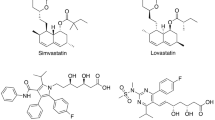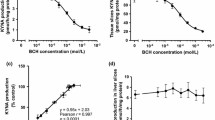Abstract
We investigated the interaction of acetylcholinesterase (AChE) inhibitors with acetyl-l-carnitine (ALCAR) transporter at the blood–brain barrier (BBB). ALCAR uptake by conditionally immortalized rat brain capillary endothelial cell lines (TR-BBB cells), as an in vitro model of BBB, were characterized by cellular uptake study using [3H]ALCAR. In vivo brain uptake of [3H]ALCAR was determined by brain uptake index after carotid artery injection in rats. In results, the transport properties for [3H]ALCAR by TR-BBB cell were consistent with those of ALCAR transport by the organic cation/carnitine transporter 2 (OCTN2). Also, OCTN2 was confirmed to be expressed in the cells. The uptake of [3H]ALCAR by TR-BBB cells was inhibited by AChE inhibitors such as donepezil, tacrine, galantamine and rivastigmine, which IC50 values are 45.3, 74.0, 459 and 800 μM, respectively. Especially, donepezil and galantamine inhibited the uptake of [3H]ALCAR competitively, but tacrine and rivastigmine inhibited noncompetitively. Furthermore, [3H]ALCAR uptake by the rat brain was found to be significantly decreased by quinidine, donepezil and galantamine. Our results suggest that transport of AChE inhibitors such as donepezil and galantamine through the BBB is at least partly mediated by OCTN2 which is involved in transport of ALCAR.





Similar content being viewed by others
References
Pettegrew JW, Levine J, McClure RJ (2000) Acetyl-l-carnitine physical-chemical, metabolic, and therapeutic properties: relevance for its mode of action in Alzheimer’s disease and geriatric depression. Mol Psychiatry 5:616–632
Dolezal V, Tucek S (1981) Utilization of citrate, acetylcarnitine, acetate, pyruvate and glucose for the synthesis of acetylcholine in rat brain slices. J Neurochem 36:1323–1330
Virmani MA, Caso V, Spadoni A et al (2001) The action of acetyl-l-carnitine on the neurotoxicity evoked by amyloid fragments and peroxide on primary rat cortical neurones. Ann NY Acad Sci 939:162–178
Mroczkowska JE, Roux FS, Naleçz MJ et al (2000) Blood-brain barrier controls carnitine level in the brain: a study on a model system with RBE4 cells. Biochem Biophys Res Commun 267:433–437
Kido Y, Tamai I, Ohnari A et al (2001) Functional relevance of carnitine transporter OCTN2 to brain distribution of l-carnitine and acetyl-l-carnitine across the blood-brain barrier. J Neurochem 79:959–969
Inano A, Sai Y, Nikaido H et al (2003) Acetyl-l-carnitine permeability across the blood-brain barrier and involvement of carnitine transporter OCTN2. Biopharm Drug Dispos 24:357–365
Friedrich A, Prasad PD, Freyer D et al (2003) Molecular cloning and functional characterization of the OCTN2 transporter at the RBE4 cells, an in vitro model of the blood-brain barrier. Brain Res 968:69–79
Berezowski V, Miecz D, Marszałek M et al (2004) Involvement of OCTN2 and B0,+ in the transport of carnitine through an in vitro model of the blood-brain barrier. J Neurochem 91:860–872
Inazu M, Takeda H, Maehara K et al (2006) Functional expression of the organic cation/carnitine transporter 2 in rat astrocytes. J Neurochem 97:424–434
Wu X, Huang W, Prasad PD et al (1999) Functional characteristics and tissue distribution pattern of organic cation transporter 2 (OCTN2), an organic cation/carnitine transporter. J Pharmacol Exp Ther 290:1482–1492
Ganapathy ME, Huang W, Rajan DP et al (2000) Beta-Lactam antibiotics as substrates for OCTN2, an organic cation/carnitine transporter. J Biol Chem 275:1699–1707
Hirano T, Yasuda S, Osaka Y et al (2006) Mechanism of the inhibitory effect of zwitterionic drugs (levofloxacin and grepafloxacin) on carnitine transporter (OCTN2) in Caco-2 cells. Biochim Biophys Acta 1758:1743–1750
Hirano T, Yasuda S, Osaka Y et al (2008) The inhibitory effects of fluoroquinolones on l-carnitine transport in placental cell line BeWo. Int J Pharm 351:113–118
MaNally WP, Pool WF, Sinz MW et al (1996) Distribution of tacrine and metabolites in rat brain and plasma after single- and multiple-dose regimens; evidence for accumulation of tacrine in brain tissue. Drug Metab Dispos 24:628–633
Matsui K, Mishima M, Nagai Y et al (1999) Absorption, distribution, metabolism, and excretion of donepezil (Aricept) after a single oral administration to rat. Drug Metab Dispos 27:1406–1414
Polinsky RJ (1998) Clinical pharmacology of rivastigmine: a new-generation acetylcholinesterase inhibitor for the treatment of Alzheimer’s disease. Clin Ther 20:634–647
Kang YS, Lee KE, Lee NY et al (2005) Donepezil, tacrine and alpha-phenyl-n-tert-butyl nitrone (PBN) inhibit choline transport by conditionally immortalized rat brain capillary endothelial cell lines (TR-BBB). Arch Pharm Res 28:443–450
Lee NY, Kang YS (2010) The inhibitory effect of rivastigmine and galantamine on choline transport in brain capillary endothelial cells. Biomol Ther 18:65–70
Thal LJ, Calvani M, Amato A et al (2000) A 1-year controlled trial of acetyl-l-carnitine in early-onset AD. Neurology 55:805–810
Bianchetti A, Rozzini R, Trabucchi M (2003) Effects of acetyl-l-carnitine in Alzheimer’s disease patients unresponsive to acetylcholinesterase inhibitors. Curr Med Res Opin 19:350–353
Hosoya K, Takashima T, Tetsuka K et al (2000) mRNA expression and transport characterization of conditionally immortalized rat brain capillary endothelial cell lines; a new in vitro BBB model for drug targeting. J Drug Target 8:357–370
Kang YS, Ohtsuki S, Takanaga H et al (2002) Regulation of taurine transport at the blood-brain barrier by tumor necrosis factor-alpha, taurine and hypertonicity. J Neurochem 83:1188–1195
Terasaki T, Hirai K, Sato H et al (1989) Absorptive-mediated endocytosis of a dynorphin-like analgesic peptide, E-2078 into the blood-brain barrier. J Pharmacol Exp Ther 251:351–357
Terasaki T, Ohtsuki S, Hori S et al (2003) New approaches to in vitro models of blood-brain barrier drug transport. Drug Discov Today 8:944–954
Ohashi R, Tamai I, Yabuuchi H et al (1999) Na+-dependent carnitine transport by organic cation transporter (OCTN2): its pharmacological and toxicological relevance. J Pharmacol Exp Ther 291:778–784
Ohashi R, Tamai I, Nezu J et al (2001) Molecular and physiological evidence for multifunctionality of carnitine/organic cation transporter OCTN2. Mol Pharmacol 59:358–366
Nakanishi T, Hatanaka T, Huang W et al (2001) Na+- and Cl-coupled active transport of carnitine by the amino acid transporter ATB(0, +) from mouse colon expressed in HRPE cells and Xenopus oocytes. J Physiol 532:297–304
Sloan JL, Mager S (1999) Cloning and functional expression of a human Na+ and Cl− dependent neutral and cationic amino acid transporter B0+. J Biol Chem 274:740–745
Akanuma S, Hori S, Ohtsuki S et al (2008) Expression of nuclear receptor mRNA and liver X receptor-mediated regulation of ABC transporter A1 at rat blood-brain barrier. Neurochem Int 52:669–674
Gründemann D, Harlfinger S, Golz S et al (2005) Discovery of the ergothioneine transporter. Proc Natl Acad Sci USA 102:5256–5261
Okura T, Hattori A, Takano Y et al (2008) Involvement of the pyrilamine transporter, a putative organic cation transporter, in blood-brain barrier transport of oxycodone. Drug Metab Dispos 36:2005–2013
Tachikawa M, Takeda Y, Tomi M et al (2010) Involvement of OCTN2 in the transport of acetyl-l-carnitine across the inner blood-retinal barrier. Invest Ophthalmol Vis Sci 51:430–436
Kim MH, Maeng HJ, Yu KH et al (2009) Evidence of carrier-mediated transport in the penetration of donepezil into the rat brain. J Pharm Sci 99:1548–1566
Okura T, Ito R, Ishiguro N et al (2007) Blood-brain barrier transport of pramipexole, a dopamine D2 agonist. Life Sci 80:1564–1571
Bickel U, Thomsen T, Fischer JP et al (1991) Galanthamine: pharmacokinetics, tissue distribution and cholinesterase inhibition in brain of mice. Neuropharmacology 30:447–454
Tiseo PJ, Rogers SL, Friedhoff LT (1998) Pharmacokinetic and pharmacodynamic profile of donepezil HCl following evening administration. Br J Clin Pharmacol 46:13–18
Johansson M, Hellstrom-Lindahl E, Nordberg A (1996) Steady-state pharmacokinetics of tacrine in long-term treatment of Alzheimer patients. Dementia 7:111–117
Jann MW, Shirley KL, Small GW (2002) Clinical pharmacokinetics and pharmacodynamics of cholinesterase inhibitors. Clin Pharmacokinet 41:719–739
Bajgar J, Bartosova L, Fusek J et al (2007) Changes of cholinesterase activities in the plasma and some tissues following administration of l-carnitine and galanthamine to rats. Neurosci Lett 411:212–216
Ramsay RR, Gandour RD, van der Leij FR (2001) Molecular enzymology of carnitine transfer and transport. Biochim Biophys Acta 1546:21–43
Acknowledgments
The authors wish to thank Dr. Terasaki for providing TR-BBB cell lines and Novartis International Pharmaceutical Ltd. for providing rivastigmine very kindly. This work was supported by the SRC Research Center for Women’s Diseases and the National Research Foundation of Korea (NRF) grant funded by the Korea government (MEST) (No. 2011-0030701).
Author information
Authors and Affiliations
Corresponding author
Rights and permissions
About this article
Cite this article
Lee, NY., Choi, HO. & Kang, YS. The Acetylcholinesterase Inhibitors Competitively Inhibited an Acetyl l-Carnitine Transport Through the Blood–Brain Barrier. Neurochem Res 37, 1499–1507 (2012). https://doi.org/10.1007/s11064-012-0723-3
Received:
Revised:
Accepted:
Published:
Issue Date:
DOI: https://doi.org/10.1007/s11064-012-0723-3




